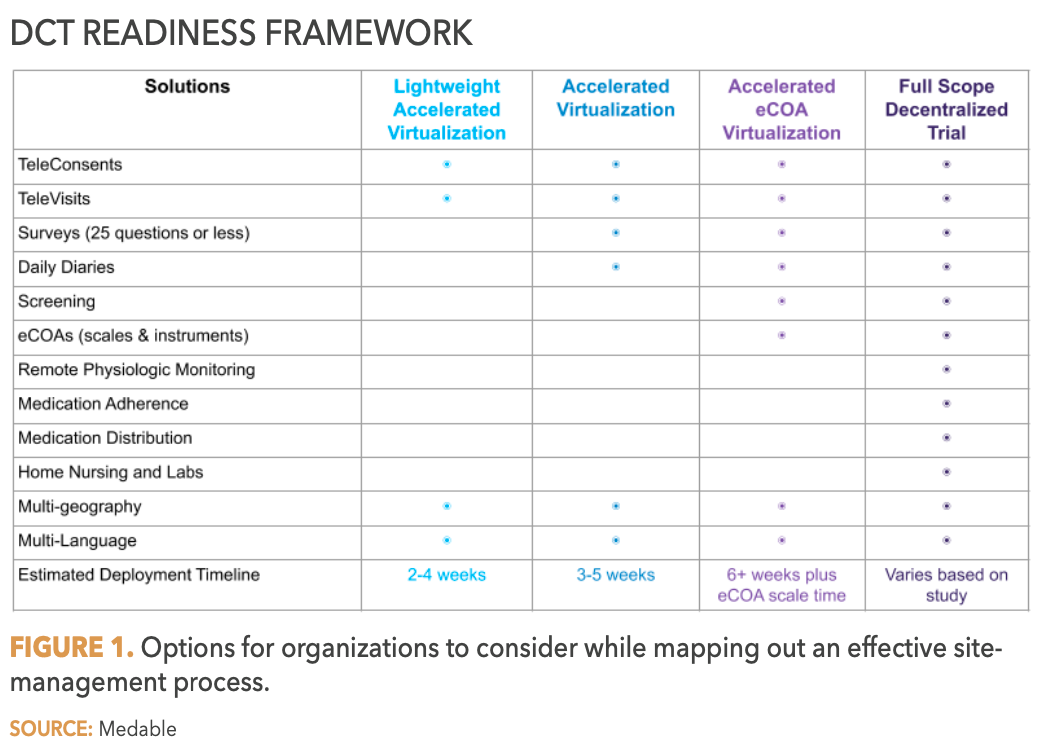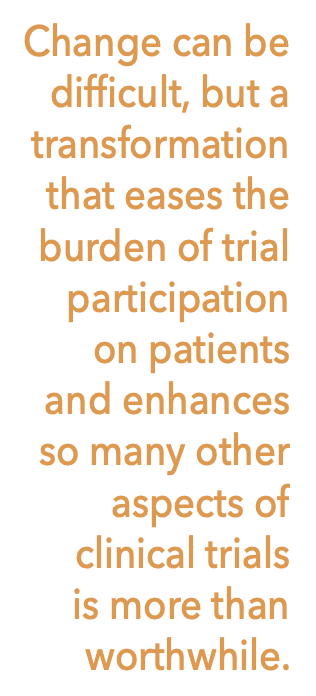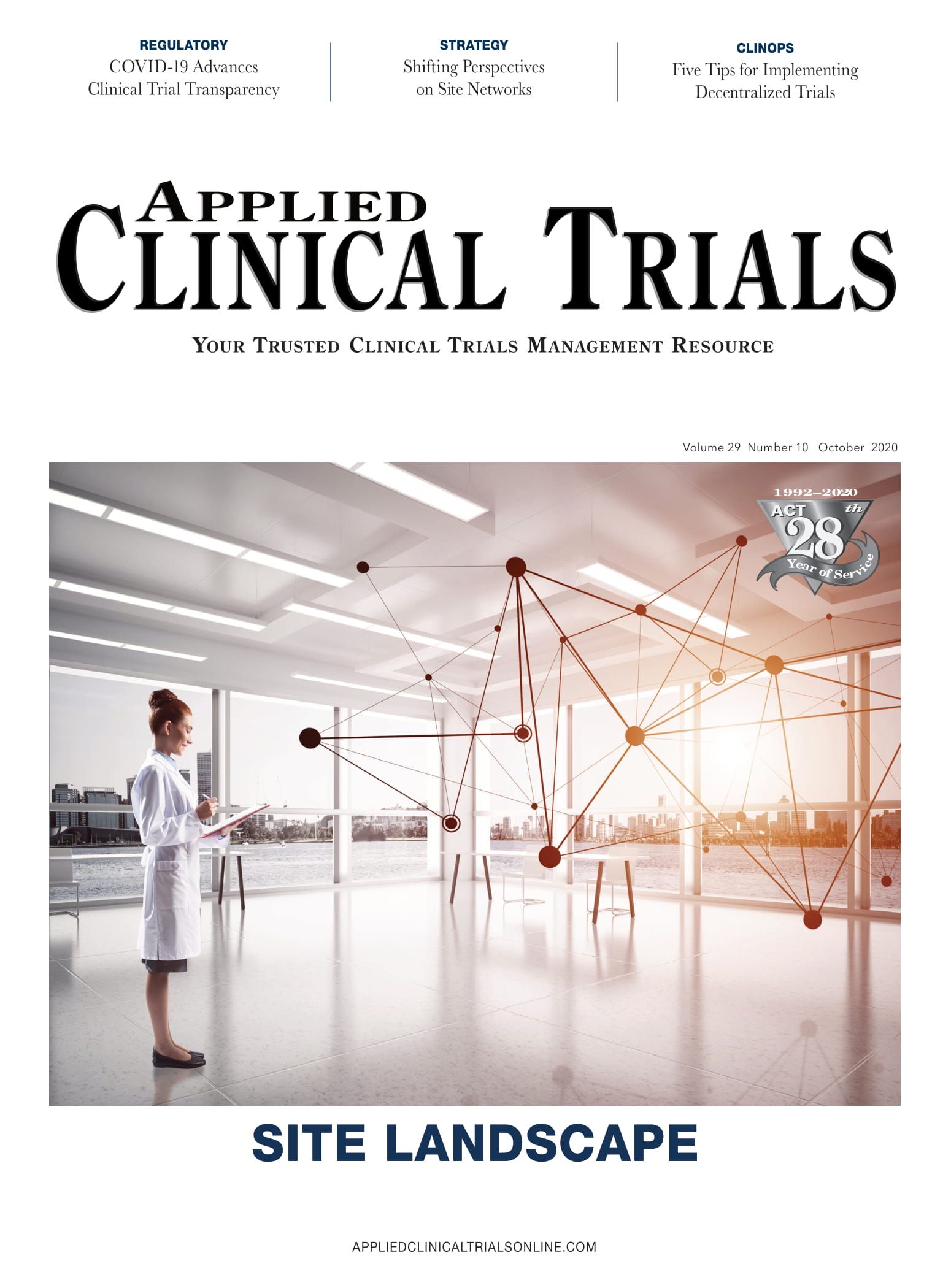Five Tips to Help Research Sites Implement Decentralized Clinical Trials
Decentralized clinical trials (DCTs) have ignited clinical transformation while the COVID-19 pandemic has fueled their rapid expansion.
Mary Costello

Nearly two-thirds of clinical research sites say they are willing to conduct hybrid or virtual clinical trials, and more than half say they would do “whatever is required” to conduct a virtual study.1 Patients are also eager to participate. In a recent study, 75% of patients say that collecting all study data from their own home is appealing and 73% like the idea of a hybrid trial.2
While the convenience, speed, and potential data quality improvements that come with decentralized clinical trials (DCTs) are inspiring, implementing DCTs can seem intimidating to investigators who haven’t participated in largely virtual studies.

“Consider how to embrace DCTs in a way that creates opportunity for your site and your patients. We must innovate to meet patient needs,” said Amanda Wright, vice president of partnership development at Javara, an integrated research organization that, in partnership with Wake Forest Baptist Health, is working on a Phase III clinical research study to evaluate the safety and effectiveness of mRNA-1273, a vaccine candidate against COVID-19 sponsored by Moderna. “You don’t have to decentralize every element of every study. Start where you’re comfortable. Carefully evaluate which components of each study can be decentralized, such as using remote monitoring devices to collect vitals such as weight and blood pressure without an in-person visit.”
With proper evaluation and planning, sites can avoid unexpected obstacles and reap the benefits of a DCT. Here are five key considerations to enable an easier transition to decentralized research.
1. Change management: Know what to expect
DCTs do not mean studies are entirely virtual, and often follow a hybrid model that leverages digital technologies like eConsent, telemedicine, wearable devices, electronic clinical outcome assessments (eCOAs), and electronic health (eHealth) records for various parts of the process. These technologies can improve patient centricity by reducing the burden of in-person visits and manual activities like paper diaries. Additionally, DCTs provide patients with interpersonal reassurance and support with technology to enable interactions at a time and place that suits patients and caregivers, which often leads to a better-quality interaction.
The obstacles to DCTs for sites range from fear of irrelevance, difficulty transitioning from paper to technology, the potential for patient resistance, patient populations without access to the internet, and concerns about data security and privacy.
Sites can overcome those challenges to improve outcomes and experience for all stakeholders. DCTs benefit sites by providing3:
- Expanded trial access and diversity of participants
- Improved data accuracy and robustness
- Improved patient engagement and retention
- Expedited patient identification and cost reduction
- Increased capacity for additional studies
As sites become more comfortable with DCTs, they may realize that DCTs can actually enable a closer patient-physician/site relationship than a traditional, randomized clinical trial can. DCTs enhance the patient-physician/site relationship in a virtual world by providing modular options and more choices.
Even so, a thorough change management process is imperative. Map out the options best for your site and include those that are already part of your infrastructure (see Figure 1 below). When creating messaging to staff and patients about the new options, for example, reinforce that it is an opportunity to ease burden and improve the workflow for everyone. Highlight to study teams, investigators, and patients that there will be choices about how to participate in a study.
Click to enlarge

“Preparation is key. You may need to customize your strategy for subgroups that are less comfortable with technology. It’s also imperative to understand your population’s access to the internet. This will help inform your search for the right technology partner and your implementation plan,” explained Patricia S. Larrabee, founder and CEO at Rochester Clinical Research. “Staff will be excited that data collection is faster, in real-time, and that the risk of losing paper documents will diminish. Televisits are not without challenges, but they have allowed us to continue studies during the pandemic. We always need to be ready to see patients remotely and sometimes after hours, particularly to assess adverse reactions. DCTs make it possible.”
2. Technology:What to look for in partners and solutions
There are several technology solutions in the marketplace, so it can be challenging to evaluate what is best for each individual organization. Of course, a DCT technology solution must support principal investigators in managing the care and safety of patients, but what else should be considered? Should it be an end-to-end product that covers all your technology needs? Does the solution accommodate hybrid studies? What is important to look for in the user interface?
Typically, there’s no need to do a complete technology overhaul. The best approach is to integrate all systems, including existing systems, and ensure your primary solution is built modularly. It allows sites to customize which studies, or parts of a study, to decentralize, as not every site or patient is ready to digitize every element of the process. As critical, the platform must seamlessly integrate with wearables and patient-collected data.
“No one needs one more piece of technology that doesn’t talk to your other systems; it needs to integrate,” said Larrabee. “And even more so, it should not require a software engineer to use it.”
When it comes to ensuring patient centricity, opt for a solution that has a simple, single sign-on to provide patients with ‘one way in and one way out,’ as Wright suggests, to minimize the learning curve. This will also significantly reduce tech support burdens for sites. Another important consideration for patients is internet access. Look for a system and provider that can meet the needs of participants without consistent internet access. For example, some DCT vendors provide devices that can work as hot spots.
In addition to the technology itself, consider the provider. For example, the vendor’s product development efforts should be informed with input from sites, such as a core bench of site advisors, so product development does not take place in a vacuum. For example, sites say that redundant questions are a significant pain point of inefficiency. So platforms that incorporate such feedback into forms, workflows, product ideation, and other areas will yield greater success. Similarly, technology providers should have a patient advisory council that provides input to product development and participates in user testing.
“The vendor should demonstrate that product design and user testing included patients of all ages and technical abilities. We must not assume that all patients have internet access or smart phones with data plans. Trials need diverse participants, so we must be able to include those without access to internet or their own technology. A technology vendor who addresses that is key,” noted Larrabee. “We also want partners who understand the site perspective. Make sure you have a chance to try using the solution before making a final commitment to ensure it really does what they say it does. Finally, the solution must be HIPAA compliant.”
3. Charting the course: Planning and training
The recommendations provided by the Clinical Trials Transformation Initiative (CTTI)4, a public-private partnership co-founded by Duke University and the FDA, are an important foundation when creating your implementation plan and training. The recommendations cover topics such as protocol design, state-level telemedicine issues, drug supply chain, mobile healthcare providers, investigator delegation and oversight and safety monitoring.
Early in the process, it is critical to map out a plan for general implementation that includes a thorough training process for staff and patients. It’s essential that training goes beyond feature and function to incorporate the “why’s” for staff and patients. With any new process, understanding the why’s and how each person benefits helps to ensure success. Since coordinators will be a source of tech support for patients, establish a “super user” at each location.
Many sites have found that DCTs offer flexibility for staff to work from home on occasion. Mapping out work-from-home standards that align with security and privacy regulations may seem daunting, but many have found that the added flexibility helps retain valuable team members. And documentation provides everyone involved with the reassurance they need to embrace new processes and technology.
Be sure to carefully craft messaging for patients about the security and privacy of information. The message should reflect patients’ cultural sensitivities. For example, in some countries, patients may have fears about items such as images of a medication being stored on their mobile device. Real-time information also means real-time responsibility. Therefore, structures need to be in place for responding to data collected through the technology and it may require new decision-support processes—experienced DCT technology providers can help map this out.
“Update your operating procedures, job descriptions, and performance criteria accordingly to ensure tech proficiency,” added Larrabee. “Listen to the end users, appoint several champions, give them time to learn it, and most of all, make sure they can see the big picture. Make it work by listening and responding to their needs.”
4. Guiding principle: Patients drive process
Patient centricity is a common term today, but making sure patients are at the center of DCT processes and technology is the key to success. Considerations for patient safety, patient engagement, and logistics are all part of the equation. Here’s how to keep that commitment.
Patients need the ability to choose which elements of a study they wish to do remotely and which they prefer to do in person. Since one size does not fit all, modular flexibility is so important. There must be choices for patients—and physicians/sites. Platforms with an interface that mirrors consumer technology like Amazon or Google also go a long way in helping patients feel comfortable.
“This is an opportunity to reach patients we otherwise could not, and patients want choices,” agreed Wright. “Patient experience and engagement is critical to the success of any trial. The better your patient’s experience, the more likely they will participate in another trial or refer a friend or family member, too.”
Larrabee continued, “Our focus on patient experience can’t end at the in-person encounter. The technology we use to interact with patients and the way we use it, needs to reflect the same standards we adhere to for all other aspects of the patient experience.”
5. Cycle of improvement: Measure and adjust
As with any business process, the utilization of DCTs must continuously improve. However, as DCTs continue to evolve, the patient feedback loop is exponentially important. Surveying patients is a great start, but the industry also needs to respond to feedback with meaningful change with each new lifecycle.

DCT technology innately enables ease of information flow to make better clinical decisions. Measure operational and patient/staff experience results regularly—to both collect feedback and to have quantifiable metrics to evaluate against the next time. For example, one investigator site implemented a digital data collection tool to increase efficiencies for both patients and staff. Patients no longer had to fill out a handwritten document, go to the site, and turn it in. Staff were able to see the patient responses in real-time in the app instead of transcribing in writing from the patient’s paper document. Their patient experience survey results were excellent, with the majority rating as very good/good.
“Efficiency is key. We measured the efficiency of regulatory document submission and found an increase in speed of 50% by going digital in just that one area,” concluded Larrabee. “Service is important in our industry. Listen, listen, and listen more. Encourage your staff to give feedback as well; we are all still learning.”
Change can be difficult, but a transformation that eases the burden of trial participation on patients and enhances so many other aspects of clinical trials is more than worthwhile. No two sites or patients are the same. The industry must continue to listen to its constituents and strive to meet the challenges of diverse communities. As these experts have explained, things are evolving and far from perfect, but through collaboration and insights from all stakeholders, we can enhance the access, data quality, and efficiency of clinical research.
References
- Milam, D., “Hybrid Decentralized Trials: Using Technology to Create More Patient-Centric Studies,” Clinical Leader, (Nov. 5, 2019). See full resource: https://www.clinicalleader.com/doc/hybrid-decentralized-trials-using-technology-to-create-more-patient-centric-studies-0001
- Tufts Center for the Study of Drug Development, “Rising protocol complexity is hindering study performance, cost, and efficiency,” Impact Report, Volume 20, Number 4, (July/August 2018). See full resource: https://static1.squarespace.com/static/5a9eb0c8e2ccd1158288d8dc/t/5b4de76e352f53bd7a416e1b/1531832174796/julaug-summary.pdf
- Holland, A., “The Centricity of Decentralizing Risk-Based Clinical Trials.” Clinical Researcher, Volume 34, Issue 7, (August 2020). See full resource: https://acrpnet.org/2020/08/10/the-centricity-of-decentralizing-risk-based-clinical-trials/
- Tenaerts, P. and Randall, P., “Overcoming Barriers in Conducting Decentralized Clinical Trials,” Applied Clinical Trials, (Feb. 4, 2020). See full resource: https://www.appliedclinicaltrialsonline.com/view/overcoming-barriers-conducting-decentralized-clinical-trials
Mary Costello, Head of Site and Investigator Networks, Medable
